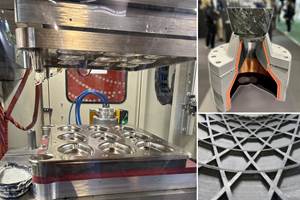HRC highlights automotive material innovation, scalable manufacturing and sustainable systems
The composites company is meeting the transition to electrification and vehicle lightweighting via hybrid monocoques, use of thermoplastic composites and carbon fiber and recycling.

Hybrid monocoque. Source (All Images) | HRC
As global automakers accelerate efforts toward electrification and vehicle lightweighting, carbon fiber composites are increasingly being adopted in structural and aesthetic automotive applications. HRC (Jiangshu, China) says it is meeting this demand through a combination of advanced materials development (including the use of thermoplastic composites), efficient manufacturing technologies and closed-loop recycling systems.
HRC’s operations span across five countries. Vertically integrated capabilities — R&D, engineering and design, serial production, and recycling and reuse — supports OEMs across the entire composites life cycle, enabling scalable and sustainable solutions for next-generation mobility platforms.
Hybrid carbon fiber monocoque for structural lightweighting
Exclusively developed and manufactured by HRC, the hybrid monocoque is one example of the company’s automotive composites proficiency. It achieves a 30% weight reduction compared to conventional steel-aluminum body structures, with a reported lightweight coefficient of 0.95. To meet structural performance targets, the monocoque incorporates more than a dozen advanced joining technologies, including the use of PMI inserts at critical zones to ensure enhanced handling stability and crash safety performance under extreme working conditions, balancing the triple technical goals of lightweight, safety and driving pleasure.
According to HRC, as the largest carbon fiber monocoque in series production, the hybrid structure creates a new precedent for the use of carbon fiber as a primary structural material in high-end mass production models in automotive.
Thermoplastic composite parts for high-volume applications
Thermoplastic composite (TPC) processing is a method with significant potential for mass production HRC reports, offering advantages in efficiency, cost-effectiveness and sustainability. Ideal for mass-producing large structural components like door panels and power battery pack shells, this process features short molding cycle times, recyclability and optimal impact resistance.
HRC’s TPC door module exemplifies the application of this technology in mass-production programs. The component uses a combined compression and injection molding process, eliminating the need for secondary gluing operations typical of traditional composites fabrication.
The process is fully automated, ensuring high levels of product consistency, dimensional stability and production efficiency. By integrating structural functionality and decorative surfaces into a single forming cycle, the solution supports reduced part count and assembly complexity.
This approach not only improves throughput and repeatability but also aligns with circular economy objectives, as the materials can be reprocessed at end of life — supporting OEMs in meeting sustainability and lightweighting targets simultaneously.
Surface-grade performance components
Beyond structural components, HRC is exploring design-driven uses of carbon fiber. In applications where structural performance meets aesthetic demands, HRC develops carbon fiber components that combine mechanical function with distinctive visual appeal.
The full carbon fiber wheel hub, for example, reduces mass by more than 40% compared to conventional metal wheels, effectively lowering the load on the vehicle’s suspension system and improving both handling and acceleration.
The rear bumper lower trim assembly, fully designed with aerodynamic principles, combines track-level performance with a distinctive visual identity. The component features sharp, tall and streamlined diffuser fins on the left and right lower bumper fins, paired with distinctive carbon fabric textures makes the product stands out dynamically or when stationary.
The aerodynamic winglet structures are defined by thin, towering cross-sections and sharp contours, engineered to contribute both to aerodynamic efficiency and styling. The exposed carbon fiber weave pattern delivers high-performance character of the part, giving it a strong visual impact.
Recycled composites, closed-loop systems
HRC also emphasizes its implementation of a closed-loop system covering development, industrial application, recycling and reuse of composite materials. It uses its patented microwave pyrolysis technology to transform carbon fiber wasted into recycled carbon fiber (rCF). Through advanced thermoplastic processes, this material is then turned into cost-effective and eco-friendly automotive components (learn more about the closed-loop system here).
The final rCF thermoplastic automotive parts demonstrates HRC’s “waste-to-product” green manufacturing business model and proves the compatibility of high-end composites with circular economy principles.
As the automotive industry navigates rapid transitions in electrification, sustainability and smart manufacturing, lightweighting remains central to improving vehicle range, performance and safety. HRC continues to invest in material innovation, scalable manufacturing and sustainable systems —enabling OEMs to meet evolving performance requirements without compromise.
Related Content
Thermoplastic composites: Cracking the horizontal body panel nut
Versatile sandwich panel technology solves decades-long exterior automotive challenge.
Read MoreWelding is not bonding
Discussion of the issues in our understanding of thermoplastic composite welded structures and certification of the latest materials and welding technologies for future airframes.
Read MorePlant tour: Sekisui Aerospace, Orange City, Iowa, Renton and Sumner, Wash., U.S.
Veteran composites sites use kaizen and innovation culture to expand thermoplastic serial production, 4.0 digitization and new technology for diversified new markets.
Read MoreJEC World 2024 highlights: Thermoplastic composites, CMC and novel processes
CW senior technical editor Ginger Gardiner discusses some of the developments and demonstrators shown at the industry’s largest composites exhibition and conference.
Read MoreRead Next
McLaren develops aerospace-inspired ART method for volume composite super car engineering
Automated rapid tape (ART) technique, already deployed at the MCTC and to be used for future McLaren models, is capable of producing lighter, stiffer and stronger carbon fiber structures with less waste.
Read MoreMoving toward sustainable automotive parts manufacturing
How can the automotive supply chain prepare for future sustainability requirements? Tier 1 Kautex Textron discusses emissions reduction, design for circularity and transition to recycled/bio-based plastics.
Read MoreForvia divests Faurecia Lightweight Solutions business to ASC
French automotive supplier Faurecia Automotive Composites becomes Compositec, intending a complete focus on composite-based solutions for its customers.
Read More





























